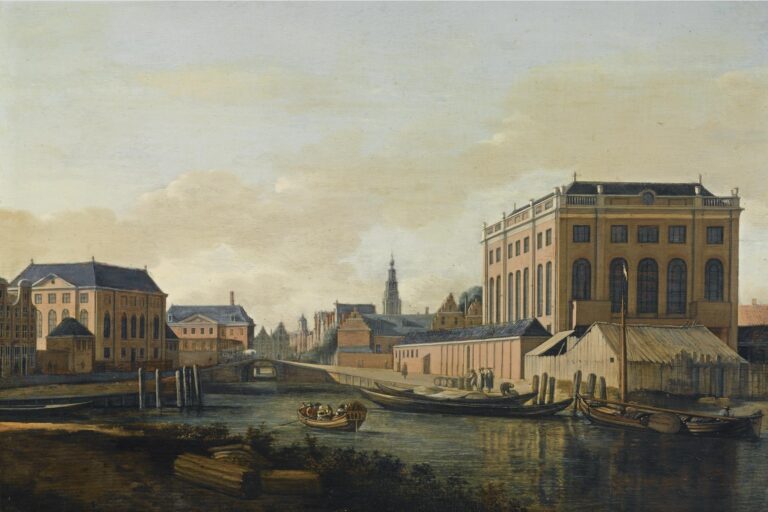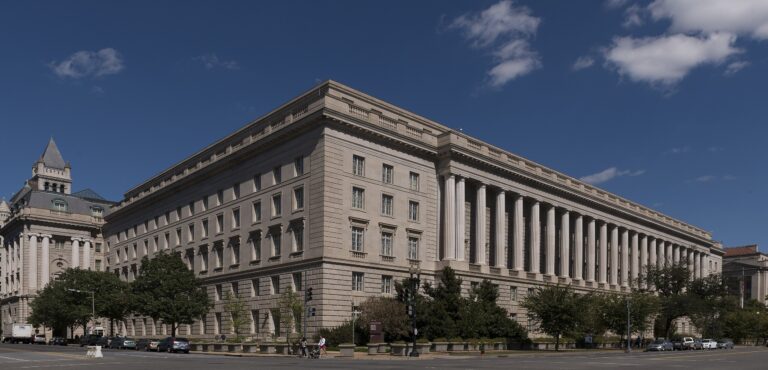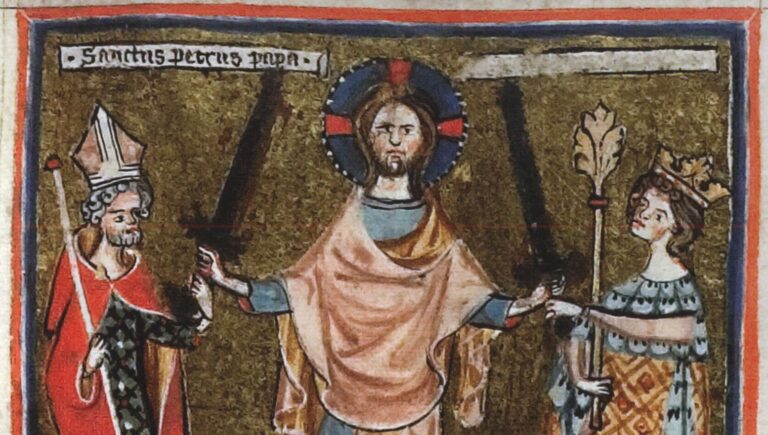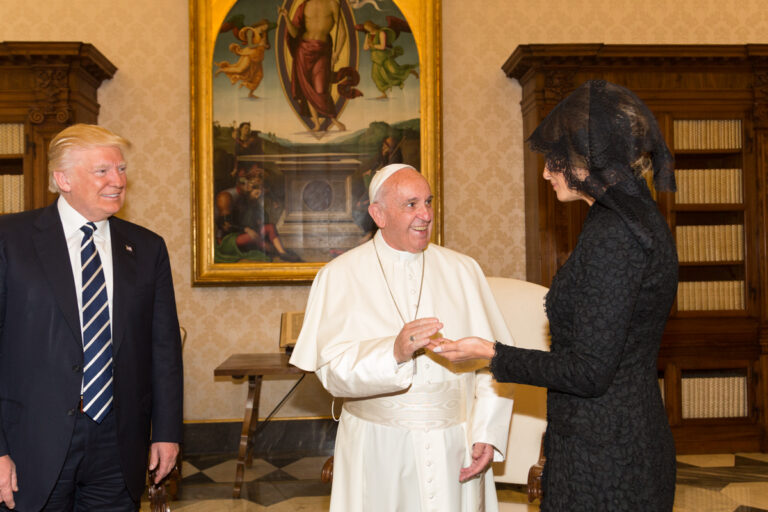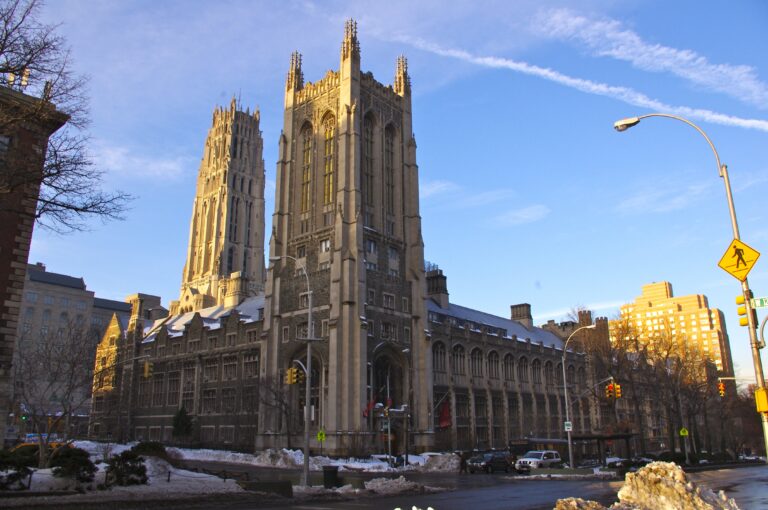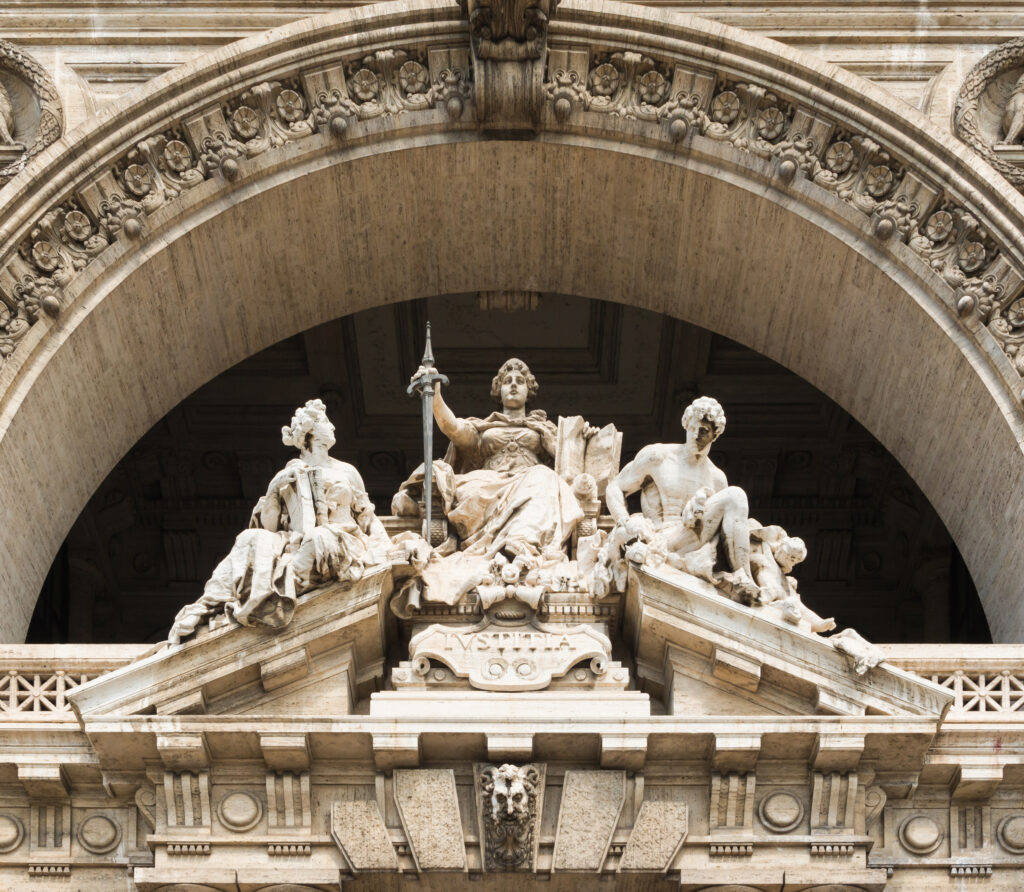
Transformations and Persistences Between Law and Religion in the Italian Legal Science of the Modern Age
Alarico Barbagli
Lady Justice at The Palace of Justice, Rome, Italy by Jebulon (CC0 1.0)
Against the backdrop of the affirmation of the Modern State and the birth of national legal systems, the hundred years from the mid-sixteenth century to the mid-seventeenth century represent a period full of changes for Europe also in the legal field. As regards the science of law, we witnessed almost simultaneously the full maturation of legal humanism, especially in France and the Netherlands, the extraordinary flowering of studies on natural law by the jurist-theologians of the School of Salamanca, and the powerful development of legal treatises heir to the great tradition of medieval legal science. All these strands, and their intersections, have been passionate about legal historiography in the past, and still represent some of the most fruitful fields of investigation.
Canon law could not remain indifferent to the changes that the Church and faith went through at the beginning of the modern age. The breakdown of the religious unity of Europe, following the birth of the Reformed Churches, determined in the Catholic Church the need to provide for an overall reorganisation of its structures in order to be able to sustain the confrontation with the Protestant confessions that were rapidly spreading on the Continent. As is well known, this phase of reorganisation culminated in the Council of Trent, which carried out a general revision of the structures on which the Catholic Church had been based during the Middle Ages, both with reference to its governing structures and with regard to the more strictly theological and liturgical profiles.
Canonical juridical science was also affected by these phenomena. The jurists loyal to Rome, in fact, had to refine and perfect their working tools and, where necessary, create new ones to hold their own with their colleagues who moved on the opposite front. In this regard, in the light of the most recent historiography, the sixteenth century appears more and more as the time of the rearrangement of the rich and diversified normative and doctrinal heritage that had accumulated disorderly during the last centuries of the Middle Ages. This is evident in fields that, unlike civil law, could not count on a solid theoretical platform of Roman law to develop a legal framework suited to changing times, such as commercial law. Even in the field of Canon law, however, we witnessed the flowering of various monographic works that responded to this dynamic. Among them, we can mention, if only for the high level of its author, the treatise De episcopo (1511) by Giovanni Bertachini, a jurist known above all for his very successful dictionary of law. In De episcopis, Bertachini illustrated in four books the procedure for electing bishops and the prerogatives due to them. Very interesting are the Tres tractatus by Virginio Boccacci (d. 1596), a work worthy of being remembered above all for the practical approach that manages to combine doctrine with the jurisprudence and practices of the tribunal of the Roman Rota. The famous Sylva nuptialis (1518/1524) by Giovanni Nevizzano (c. 1485?-1540) was written with the precise intention of reorganising the immense mass of knowledge–not only juridical, but also literary, philosophical, medical and popular cultural—regarding marriage. However, some quotations from Martin Luther and criticisms of the corruption of the clergy later earned him the placing on the Index of Prohibited Books by the Council of Trent. Of some importance, if only for the success it enjoyed, was the Tractatus de censibus (1621) by Ludovico Cenci (1557- c. 1637), who was a professor for several decades at the University of Perugia: the work does not shine for originality, but has the merit of condensing in a single writing the best of doctrine, especially the Italian one, on the subject of census in the light of the most recent pontifical legislation, especially the bull Cum onus of Pius V of 1569. Also worthy of attention is the De potestate conciliorum by Tommaso Campeggi (1481-1564), diplomat and official of the Roman Curia, in which a strong interest in legal history is accompanied by an equally clear practical imprint, so much so as to lead some to define this treatise as a real “manual for the organization of councils”; the work is even more interesting as it was written while the Council of Trent was underway, the main issues of which are in fact analysed. But the work that best embodies the spirit of the jurisprudence of that time is perhaps the great commentary on the Liber Extra (1661) by Prospero Fagnani (1588-1678), still strongly linked to a medieval conception of political-legal systems, characterized by a convinced affirmation of the Pope’s plenitudo potestatis, but at the same time capable of combining the tradition of medieval legal doctrine with the reforms resulting from the Council of Trent. As regards the ecclesiastical patrimony, the De resignatione beneficiorum (1591/1593) by Flaminio Parisio (1561-1603), bishop and official of the Curia, enjoyed a certain notoriety, whose work, despite its title, essentially represents a rearrangement of the entire matter on ecclesiastical assets.
Also noteworthy are works such as the Summa peccatorum capitalium (1579) and the Summa omnium haeresum et catalogus schismaticorum, haereticorum et idolatrarum (1581) by the Florentine Sebastiano Medici (c. 1545-1595), who among the various positions held was also auditor of the court of the Rota of Macerata. These are two works that ideally followed the penitential sums and inquisitorial manuals, two genres of ecclesiastical literature halfway between law and moral theology that had enjoyed a certain success in the Late Middle Ages, and must have experienced renewed success in the period immediately following the Council of Trent, when the sums ordered alphabetically were considered valid tools for the education of the clergy: The penitential sums, or summae confessorum, and the inquisitorial manuals, in fact consisted of useful practical guides intended for confessors and inquisitors, within which it was possible to easily find the widest number of solutions to moral problems, arranged according to the alphabetical criterion, to then develop each individual entry using the casuistic method. Especially interesting is the Summa omnium haeresum, in which the Medici reviews all the religious manifestations that, from antiquity to his time, went beyond Catholicism. Using a plurality of different sources, from the canonical tradition to theology to the great heritage of classical literature, Sebastiano Medici delivered to the modern age an overall rearrangement of the juridical-theological tradition in matters of religious diversity, the fruit of the union between the different souls that made up the cultural system of post-Tridentine Catholicism. Similar to the works of the Medici, if only for the sources put to good use, is the De blasphemia, i.e. blasphemy, by Giovanni Battista Piotti (1518-1570), in which the material is rearranged by making extensive use above all of the medieval Summae confessorum.
The objective of simplification, in the field of university teaching, is at the origin of the flowering of another genre of modern legal literature that enjoyed wide success from the sixteenth century, namely the manuals of Institutes of Law. Born in the field of civil law with the not secondary contribution of French legal humanism, these works essentially consisted in a rearrangement of Roman law according to the systematics of the Justinian’s Institutes, and responded precisely to the need, strongly felt at that time, for the renewal of the methodology of university teaching of law, which was intended to be simplified and rationalised drastically compared to the past. The Institutes of Justinian, thanks to the agile structure and streamlined systematics that characterized them, seemed to many an excellent model to imitate in order to set up a new teaching methodology based on the study of more modern manuals which, firmly anchored to Roman law, at least partially surpassed the traditional genres of medieval legal literature, still based on the exegesis of the Digest of Justinian and heavily burdened by a doctrine so extensive that it is no longer dominable by the interpreters of law. Starting from the mid-sixteenth century, we witnessed the publication of similar works also in the canonical field. In particular, we must remember the Institutiones iuris canonici (1563) by Marco Antonio Cucchi (c. 1510-1582/1583), which, in imitation of civil Institutions, condensed the foundations of Canon law into four books, updated in light of the findings of the Council of Trent. Cucchi’s work benefited from immediate success, but soon ended up outclassed by Giovanni Paolo Lancellotti’s Institutiones iuris canonici (1563). Other similar works met the same fate as Cucchi’s manual, such as the Compendium iuris canonici (1580) by Francesco Graziano Garzadoro (1519?-1588). The manual by Lancellotti, a lawyer and professor at the University of Perugia, proved soon to be superior to all the others in terms of its approach and clarity of exposition, establishing itself as the main university reference text in the field of canon law in the following decades.
The activity of many jurists of the sixteenth and seventeenth centuries was also linked to the evolution of the book market. An increasingly demanding clientele, combined with growing competition between printers, led publishers and printers to produce increasingly sophisticated editions, relying on jurists who specialized in the profession of editorial editor. The editors were responsible for accompanying the editions of the great jurists of the past with a whole series of indexes, summaries, annotations, comments, and updates that made one edition more attractive than another, while also allowing even dated works to remain on the market. This phenomenon also occurred in the canonical field, where there were quite a few jurists who devoted themselves to this activity, apparently less noble than the work of the great medieval jurists, but certainly no less useful. Among them, it is worth mentioning a few. Girolamo Gigante (d. 1566?), for example, lawyer and high official of the Republic of Venice, who was the author of an apparatus of annotations to the Lectura super Decretalibus (1522-1523) by Filippo Decio. And then Giovanni Battista Bertolini (1550-1602?), professor of canon law for about thirty years at the University of Perugia, author actual apparatus of pontifical of notes to doctrinal works and legislative texts: although the structure of these works certainly does not shine for originality, some of them however enjoyed wide spread success in practitioners’ environment precisely because of their usefulness, like the Glossa on the bull Cum onus of Pius V (1592), and his annotations to the Institutiones iuris canonici by Giovanni Paolo Lancellotti (1587) and to the Tractatus de censibus by Ludovico Cenci (1621) also had the same purpose, which in the same period were also enriched by the annotations (1630) by Giovanni Luigi Riccio (1570-1643).
Simplification, rearrangement, attention to practice with the flourishing of great “practices” and collections of case studies intended above all for the use of the court – one for all the Practicae conclusiones by Domenico Toschi (1535-1620)– are the trajectories along which the science of law moved during the first two centuries of the modern age. If these works, often monumental, do not stand out for their originality of content, they nevertheless represent the manifestation of a new cultural ferment that constitutes the mirror of the needs of the legal systems of the seventeenth and eighteenth centuries, all aimed at the construction of the great structures of the modern State. The novelty of these works lies rather in the tension towards the construction of a new systematics, more functional and rational than the literary genres of the past, in which to frame the contents that flourished during the grandiose season of medieval law. A new season for European legal culture, therefore, in which canonical juridical science took part as a protagonist.♦

Alarico Barbagli (born 1977, Siena) is an associate professor at Department of Law, Economy and Sociology of University “Magna Graecia” of Catanzaro. He is Coordinator of “Legal Systems and supranational dimensions” PhD of University “Magna Graecia” of Catanzaro. He was Visiting Robbins Fellow at “Robbins Collection” of Berkeley University of California (USA) on 2018.
Recommended Citation
Barbagli, Alarico. “Transformations and Persistences Between Law and Religion in the Italian Legal Science of the Modern Age.” Canopy Forum, November 19, 2025. https://canopyforum.org/2025/11/19/transformations-and-persistences-between-law-and-religion-in-the-italian-legal-science-of-the-modern-age/.
Recent Posts



